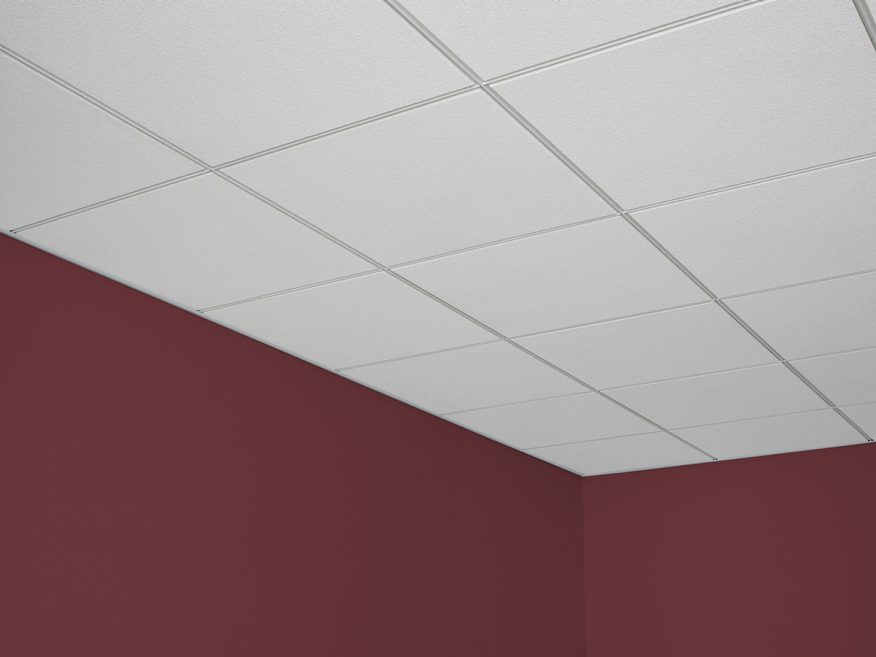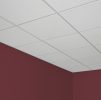Sign In
You're All Set
Welcome back! You are now signed in.
You have been logged out
You have been logged out due to inactivity
Forgot Password
Please enter the email address you used to create the account. We'll send you a link that lets you create a new password.
You're All Set
Please check your email. Click the link in the email to create a new password.
Reset Password
You're All Set
Success! Your password has been updated.
Change Password
You're All Set
Success! Your password has been updated.





Olympia™ Micro™ Acoustical Panels
Fine-textured panels. Micro perforations provide a smoother look and good sound absorption. Upscale appearance at a mid-range price.





Overview
Overview
With micro perforations that provide a smoother look and good sound absorption, these panels offer upscale appearance at a mid-range price. Olympia™ Micro™ Acoustical Panels Panels offer high level light reflectance, mold and mildew resistance, ceiling attenuation and noise absorption, making them a perfect choice for classrooms, hotels, reception and lobby areas, restaurants and retail stores.
Sound Absorption
0.60 NRC
Sound Attenuation
35 CAC
Light Reflectance
Up To 0.86
Recycled Content
61 %
Main Features
Olympia™ Micro™ Acoustical Ceiling Panels are made with a water-felted manufacturing process that provides good ceiling attenuation class (CAC) performance. An available face score panel creates the illusion of a smaller-scaled ceiling system without compromising accessibility.- Non-directional pattern reduces installation time and waste
- Economical, fine-textured panel
- Excellent light reflective finish (LR - .86) reduces light fixtures and energy use
- Available in High Recycled Content formulations to help maximize LEED recycled content contribution
- USDA Certified Biobased Product
- Available with .60 NRC
- Ceiling Attenuation Class (CAC - 30-35)
- ClimaPlus™ 30-year lifetime system warranty against visible sag, mold and mildew
- Class A
- Low-emitting product meets CA Specification 01350, California Department of Health Services Standard Practice for the testing of VOC emissions
Applications
- Administrative Offices
- Bars Restaurants and Dining Areas
- Classrooms
- Convention and Meeting Rooms
- Corridors and Hallways
- Department Stores and Boutiques
- Executive Areas, Conference Areas and Board Rooms
- Guest Rooms and Suites
- Lobbies and Reception Areas
- Mall Interior Spaces
- Patient Rooms
- Traditional Offices
Specifications
Performance
- Sound Absorption (NRC) 0.60
- Sound Attenuation (CAC) 35
- Light Reflectance 0.86
- Mold & Mildew Resistance Yes
-
Fire Resistance
- Fire Rating Class A
-
ASTM E1264
- astm-e1264-class III: Mineral base with painted finish, C: Perforated, small holes; E: Lightly textured, Form 2: Water-Felted
-
ASTM E84
- Flame Spread 25 or less
- Smoke Developed 50 or less
- Fire Rating Class A
Sustainability
- GREENGUARD Certification Yes
- Recycled Content 61%
- VOC Emissions Low-emitting
- Bio Based Yes
Physical Data
- Thickness (in.) 3/4
- Color White
- Edge Shadowline Tapered
- Panel Size 2 ft. x 4 ft.
- Material Mineral Fiber
Warranty
-
Warranty
USG Ceilings Commercial Application Warranty (English) - SC2102PDF 148 KB
Installation
Installation Guide PDF 822.1 KB
Documents & Files
Data Sheets & Specifications
| Data/Submittal Sheet (English) | PDF 1.2 MB |
| Architectural Specification (English) | DOCX 111.8 KB |
Catalogs & Brochures
| System Catalog (English) | PDF 47.2 MB |
Design Files
| CAD and Revit Files (English) |
Installation & Technical Manuals
| Technical Guide (English) | |
| Installation Guide (English) | PDF 822.1 KB |
SDS, Certifications & Reports
| SDS (English) | PDF 112.3 KB |
| SDS (Spanish) | PDF 119.7 KB |
| Certificates (English) | PDF 1.1 MB |
Warranties
| Warranties (English) | PDF 147.7 KB |
Sustainability
| HPD (English) |
| Greenguard Certificate (English) |
| EPD (English) |
Ask a question
Our customer support team will get back to you as soon as possible.
Question Guidlines
- Questions should relate to this product specifically.
- For help with pricing, availability, or delivery, please call 800.874.4968 (Monday–Friday, 7am–6pm Central)
- All questions and answers follow USG’s Terms & Conditions.
- Your question and USG’s answer may be posted to this page in the future, but none of your personal info will be included.
q & a
-
Why is LR important?
When the proper type of lighting fixture is used with a high LR ceiling, there can be savings in both initial construction costs as well as long-term energy costs. The concept is to use the ceiling to reflect light back into the occupied space.
-
What does ClimaPlus™ mean?
USG’s line of products with ClimaPlus™ Performance have additional resistance to temperature and humidity. This in turn provides additional resistance to sagging and warping of the ceiling panels.
-
What does LR stand for?
LR stands for light reflectance. It is a measure of the percentage of light which is reflected off of a given panel surface. Typically, the whiter and smoother the ceiling panel, the higher the LR value.
-
What is NRC?
NRC stands for Noise Reduction Coefficient. It is a measure of how much sound is absorbed by a given material. It is listed as a decimal and relates to percentage sound absorbed.
-
When referring to ceiling panels, what is the meaning of type, form and pattern?
These categories refer to ASTM Test E 1264.
Type refers to the base material of the panel.
Form refers to the manufacturing process of the panel.
Pattern refers to the type of texture or pattern in the panel. -
What is the difference between Class A and Firecode® branded materials?
Class A signifies that a panel attained a flame spread index of 25 or less (based on 100 for untreated red oak) when tested in accordance with the Standard ASTM E 84. The Firecode® brand signifies that the panel has been classified as a protective membrane in a floor-ceiling or roof-ceiling assembly in accordance with the Standard ASTM E 119. All Firecode® protective membranes offered by USG have attained a Class A rating.
-
What is the difference between wet-felted and cast ceiling panels?
Wet-felted panels are typically mechanically perforated and fissured. They are very dense and more economical than other types of ceiling panels. Cast ceiling panels are non-perforated and are manufactured in a different “cast” process, hence its name, that enhances their surface appearance and provides excellent sound absorption and durability.
-
How many acoustical panel types does USG offer?
USG offers four major types of acoustical panels as well as Gypsum based panels for special applications. They are: Wet-Felted, Cast, "X" Technology and Fiberglass.
-
What is the best way to cut a reveal in a ceiling panel?
The best way to cut a reveal edge in a panel is with a utility knife or a special Reveal edge tool.
-
How far in advance can I order ceiling panel before installation?
Storage time of materials at the job site should be as short as possible, and environmental conditions should be as near as possible to those specified for occupancy. Excess humidity during storage can cause expansion of material and possible warp, sag, or poor fit after installation. Chemical changes in the mat and/or coatings can be aggravated by excess humidity and cause discoloration during storage, even in unopened cartons. Cartons should be removed from pallets and stringers to prevent distortion of material. Long-term (6-12 months) storage under uncontrolled environmental conditions should be avoided.
-
What is CAC?
CAC stands for Ceiling Attenuation Class. It is the measure of the blocking of sound through one ceiling plane, into the plenum above, and back through the other ceiling plane to an adjacent space.
-
Why would I use one ceiling panel type over another?
The different panel substrates provide panels with unique characteristics. The use of the different panels will vary based on specific needs and application.
-
Have a question?
Ask USGLet us do the research. We'll get back to you as quickly as we can.
-
Need help right away?
Call our Technical Support team at 800-874-4968 (Monday-Friday, 7:30 am - 4 pm Central).



